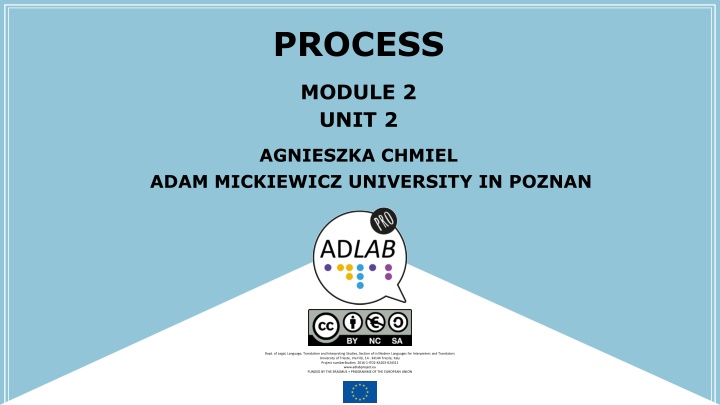
Film Sound Production Workflow and Synchrony in Translation Studies
Explore the production workflow, synchrony, and sounds in film translation studies. Learn about the role of dialogue, narration, music, and sound effects in audiovisual translation. Understand the importance of identifying sounds and off-screen voices for effective translation. Prioritize illustrative sounds to enhance the translation process.
Uploaded on | 1 Views
Download Presentation

Please find below an Image/Link to download the presentation.
The content on the website is provided AS IS for your information and personal use only. It may not be sold, licensed, or shared on other websites without obtaining consent from the author. If you encounter any issues during the download, it is possible that the publisher has removed the file from their server.
You are allowed to download the files provided on this website for personal or commercial use, subject to the condition that they are used lawfully. All files are the property of their respective owners.
The content on the website is provided AS IS for your information and personal use only. It may not be sold, licensed, or shared on other websites without obtaining consent from the author.
E N D
Presentation Transcript
PROCESS MODULE 2 UNIT 2 AGNIESZKA CHMIEL ADAM MICKIEWICZ UNIVERSITY IN POZNAN Dept. of Legal, Language, Translation and Interpreting Studies, Section of in Modern Languages for Interpreters and Translators University of Trieste, Via Filzi, 14 - 34144 Trieste, Italy Project numberStudies: 2016-1-IT02-KA203-024311 www.adlabproject.eu FUNDED BY THE ERASMUS + PROGRAMME OF THE EUROPEAN UNION
PRODUCTION WORKFLOW Remael et al. (2015)
PRODUCTION WORKFLOW Remael et al. (2015)
PRODUCTION WORKFLOW Remael et al. (2015)
PRODUCTION WORKFLOW Remael et al. (2015)
PRODUCTION WORKFLOW Remael et al. (2015)
PRODUCTION WORKFLOW Remael et al. (2015)
PRODUCTION WORKFLOW Remael et al. (2015)
FILM SOUND Dialogues. Narration. Lyrics. Sound effects. Music.
SOUNDS Obvious sounds no AD. Sounds difficult to identify name them or their source in AD.
SOUNDS Diegetic (part of reality on the screen). Non-diegetic (music or off-screen voices).
OFF-SCREEN VOICES Is it clear who is speaking? Is it important to know that?
ACTIONS CHARACTERS SETTING
PLOT PRIORITISING
AUDIO DESCRIBER = ACTIVE SEE-ER (SNYDER 2005)
REFERENCES Remael, A., Reviers, N., Vercauteren, G. (eds.) (2015). Pictures painted in Words. ADLAB Audio Description guidelines. Trieste: EUT, www.adlabproject.eu/Docs/adlab%20book/index.html Snyder, J. (2005). Audio Description. The Visual Made Verbal Across Arts Disciplines Across the Globe , Translating Today 4: 15-17.
PROCESS MODULE 2 UNIT 2 AGNIESZKA CHMIEL ADAM MICKIEWICZ UNIVERSITY IN POZNAN Dept. of Legal, Language, Translation and Interpreting Studies, Section of in Modern Languages for Interpreters and Translators University of Trieste, Via Filzi, 14 - 34144 Trieste, Italy Project numberStudies: 2016-1-IT02-KA203-024311 www.adlabproject.eu FUNDED BY THE ERASMUS + PROGRAMME OF THE EUROPEAN UNION
The preparation of this presentation was supported by ADLAB PRO (Audio Description: A Laboratory for the Development of a New Professional Profile), financed by the European Union under the Erasmus+ Programme, Key Action 2 Strategic Partnerships, Project number:2016-1-IT02-KA203-024311.
The information and views set out in this presentation are those of the authors and do not necessarily reflect the official opinion of the European Union. Neither the European Union institutions and bodies nor any person acting on their behalf may be held responsible for the use which may be made of the information contained therein.






















